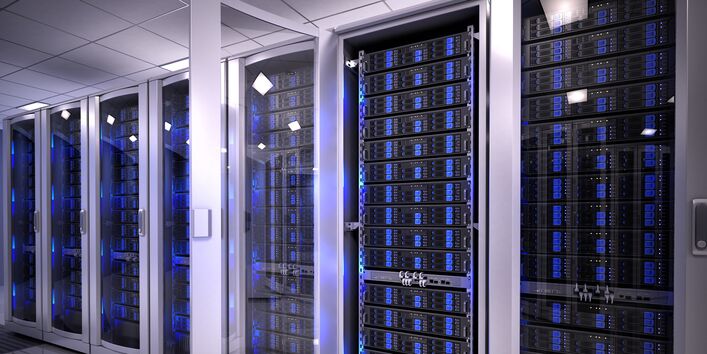Video streaming: data transmission technology crucial for climate footprint
HD-quality video streaming produces different levels of greenhouse gas emissions depending on the transmission technology. The CO2 emissions generated by data processing in a data centre are relatively low, at 1.5 grams of CO2 per hour. However, the technology used to transmit data from the data centre to the user determines the climate compatibility of cloud services like video streaming. Greenhouse gas emissions can be reduced considerably, depending on the data transmission technology used. This is shown by initial research findings commissioned by the German Environment Agency.
The lowest CO2 emissions are produced when HD video is streamed at home over a fibre optic connection, with only two grams of CO2 per hour of video streaming for the data centre and data transmission. A copper cable (VDSL) generates four grams per hour. UMTS data transmission (3G), however, produces 90 grams of CO2 per hour. If the transmission technology used to transmit data is 5G instead, only about five grams of CO2 are emitted per hour. The electricity used by the end device is not factored into this calculation.
German Environment Minister Schulze said: "To date, the data available on how digital infrastructure affects the climate has been extremely sparse. This is why we are working to bridge the existing gaps in our knowledge with solid research. After all, good policy needs to be based on good data. The most recent findings now show us that it is possible to stream data without negatively impacting the climate if you do it right and choose the right method for data transmission. From an environmental perspective, it would be a good idea to set up more public WiFi hotspots, as this is more climate-friendly than streaming in mobile networks. The climate benefit of working from home and video conferencing can even increase with the right transmission methods and more efficient data centres. My goal is to capitalise on the German EU Council Presidency to reach a common position on environmentally friendly digitalisation because the best approach would be to set good standards throughout Europe."
Dirk Messner, President of the German Environment Agency, said: "This is good news for people who like to watch movies and series. You can use streaming services at home with a fibre optic cable or VDSL without having to feel guilty about the climate. But the volumes of data all around us will grow steadily over the next few years, be it in the form of networked vehicles, home cinema or video conferencing. This is why it is important to find climate friendly transmission channels. Our research shows that we should step up investments in expanding our fibre optic networks. The new 5G transmission technology is also promising in terms of climate change mitigation."
More and more people are using cloud services. The coronavirus pandemic has further increased demand: the use of streaming services and cloud gaming rose by 30 percent between February and March 2020. In March 2020, a peak value of 9.16 TBit (terabits) of data throughput per second was measured at the world’s largest Internet node in Frankfurt am Main (DE-CIX). This is equivalent to the simultaneous transmission of more than two million HD videos and is the highest value ever measured at this node.
Reliable figures on how cloud services such as video streaming or online data storage systems impact the climate have not been available to date. Previous studies have yielded very different results, in part due to the use of different methods or different data. However, what all the studies have in common is that the findings are based on calculation models and assumptions rather than on real measurement data. Current data from the German Environment Agency on the environmental impact of cloud services makes it possible to calculate the carbon footprint of data-intensive services such as video streaming, video conferencing and online data storage more realistically than in the past. Data was measured in a large streaming data centre, among other places.
The study also looked at the data volumes for different video resolutions. Transmission in ultra-HD resolution on a TV requires ten times as much data as HD quality, in other words 7 GB per hour instead of 700 MB per hour. Users can reduce CO2 emissions by watching films at a lower resolution. For devices with a small display, the difference in quality is not even perceptible to the human eye. A website operator with videos on his or her site should set the autoplay function to “Off” by default to conserve data and reduce CO2 emissions.
Further information
These findings were compiled on behalf of the German Environment Agency by the Öko-Institut and Fraunhofer Institute for Reliability and Microintegration (IZM) as part of the Green Cloud Computing research project. The calculations are based on data recorded in data centres and data from technical data sheets. The life cycle inventory model in this study is based on the KPI4DCE indicator model (UBA 2018). This model can be used to assess the life cycle phases of the creation and use of a data centre. The KPI4DCI indicator model was supplemented as part of the Green Cloud Computing research project for the environmental impact assessment of a data centre’s cloud computing services. The complete results and the final report are expected in December.



